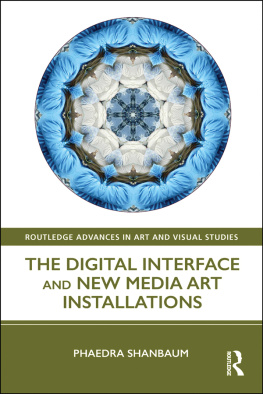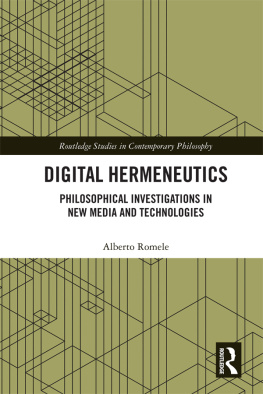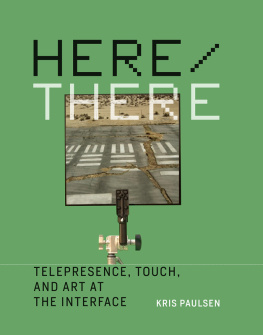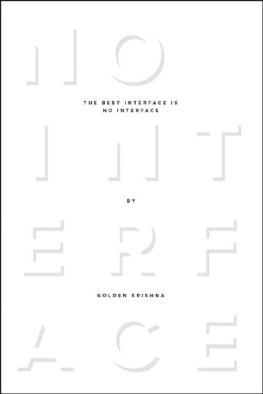
Digital Interfacing
This book takes the interfaceor rather to interface, a process rather than a discrete object or locationas a concept emblematic of our contemporary embodied relationship with technological artefacts. The fundamental question addressed by this book is: how can we understand what it means to perceive or act upon the world as a bodyartefact assemblage? Black works to clarify the role of artefacts of all kinds in human perception and action, then considers the ways in which new digital technologies can expand and transform this capacity to change our mode of engagement with our environment. Throughout, the discussion is grounded in specific technologiessome already familiar and some still in development (new virtual reality and brainmachine interface technologies, natural user interfaces, etc.). In order to develop a detailed, generalisable theory of how we interface with technology, Black assembles an analytical toolkit from a number of different disciplines, including media theory, ethology, clinical psychology, cultural theory, philosophy, science and technology studies, cultural history, aesthetics and neuroscience.
Daniel Black teaches Communications and Media Studies in the School of Media, Film and Journalism at Monash University, Australia.
Routledge Studies in New Media and Cyberculture
The Politics of Ephemeral Digital Media
Permanence and Obsolescence in Paratexts
Edited by Sara Pesce and Paolo Noto
Studying Digital Media Audiences
Perspectives from Australasia
Edited by Craig Hight and Ramaswami Harindranath
Between the Public and Private in Mobile Communication
Edited by Ana Serrano Tellera
Performing Digital Activism
New Aesthetics and Discourses of Resistance
Fidle A. Vlavo
Online Activism in Latin America
Edited by Hilda Chacn
Becoming-Social in a Networked Age
Neal Thomas
Free Software, the Internet, and Global Communities of Resistance
Sara Schoonmaker
Gay Men, Identity and Social Media
A Culture of Participatory Reluctance
Elija Cassidy
Digital Gambling
Theorizing Gamble-Play Media
Csar Albarrn-Torres
Digital Interfacing
Action and Perception through Technology
Daniel Black
First published 2019
by Routledge
52 Vanderbilt Avenue, New York, NY 10017
and by Routledge
2 Park Square, Milton Park, Abingdon, Oxon OX14 4RN
Routledge is an imprint of the Taylor & Francis Group, an informa business
2019 Taylor & Francis
The right of Daniel Black to be identified as author of this work has been asserted by him in accordance with sections 77 and 78 of the Copyright, Designs and Patents Act 1988.
All rights reserved. No part of this book may be reprinted or reproduced or utilized in any form or by any electronic, mechanical, or other means, now known or hereafter invented, including photocopying and recording, or in any information storage or retrieval system, without permission in writing from the publishers.
Trademark notice: Product or corporate names may be trademarks or registered trademarks, and are used only for identification and explanation without intent to infringe.
Library of Congress Cataloging-in-Publication Data
Names: Black, Daniel (Daniel Ariad), author.
Title: Digital interfacing : action and perception through technology /
Daniel Black.
Description: London ; New York : Routledge, 2018. | Series: Routledge
studies in new media and cyberculture ; 43 | Includes bibliographical
references and index.
Identifiers: LCCN 2018039388 (print) | LCCN 2018040828 (ebook) |
ISBN 9780429425172 (ebook) | ISBN 9781138353886 (hardback :
alk. paper) | ISBN 9780429425172 (ebk)
Subjects: LCSH: Human-machine systemsPhilosophy. |
Digital mediaPsychological aspects.
Classification: LCC T14 (ebook) | LCC T14 .B47 2018 (print) |
DDC 004.01/9dc23
LC record available at https://lccn.loc.gov/2018039388
ISBN: 978-1-138-35388-6 (hbk)
ISBN: 978-0-429-42517-2 (ebk)
Typeset in Sabon
by Apex CoVantage, LLC
If all you have is a hammer, everything looks like a nail.
origins unclear
Note
. While this principle is sometimes referred to as Maslows hammer (because of Maslow, 1966, pp. 1516), it seems that Abraham Maslow was referencing an idea already in circulation at his time of writing.
According to Erasmuss proverb, In the land of the blind, the one-eyed man is king. But it seems to me that a more plausible scenario would be, In the land of the blind, the one-eyed man is diagnosed as psychotic; after all, thats the likely fate of people in our own society who see things that dont feature in the perceptual experience of everyone around them. Even the technologically produced cyclops better known as the smartphone user, who looks at the world through a smartphone camera lens and Retina Display, while she might not be in danger of institutionalisation, still isnt attributed with superior powers of judgement or regal bearing. Take this quote from Edward Mendelson in The New York Review of Books :
In popular culture, the zombie apocalypse is now the favored fantasy of disaster in horror movies set in the near future because it has already been prefigured in reality: the undead lurch through the streets, each staring blankly at a screen.
(2016)
The smartphone user is regularly portrayed as an idiot or zombie who robbed of spatial perception like all those lacking binocular visionblunders around bumping into other people or inanimate objects, stepping into traffic or crashing their cars, and is inaccessible to social interaction. The behaviour of the smartphone user in public spaces or social settings can prompt remarks about the ironic tendency of a device ostensibly designed to increase our proficiency in tasks and facilitate social interaction through telecommunication to produce diametrically opposite results.
But of course the smartphone is increasing our proficiency in various ways and is facilitating social interaction; its just that, as with the blind population listening to the one-eyed man and hearing only an irrational fixation with things that arent there (There are beautiful stars in the sky!), the smartphone user who bumps into us in the street seems to lack mental or perceptual capacities because the focus of her attention is invisible to us. We dont see the text being read or video being watched, or the friend being interacted with.
While smartphone obsession is often characterised as an unhealthy fixation with a technological device, in most cases at least, the fixation is not on the device at all, but rather on things that are external to the device (other people, musical performances, Facebook pages), but which can only be acted upon or perceived through the device. The outside observer sees a strange relationship between human body and digital device, but for the user the digital device is the facilitator of a strange relationship between human body and something the observer isnt even aware of.
This problem of perspective is apparent in scholarship on our relationships with technological artefacts more generally. Attempts to understand our interactions with smartphones or personal computers tend to focus on the relationship between user and machine, when the experience of the user is often one in which the attributes of the machine simply inflect actions or perceptions that are directed somewhere else. This book is an attempt to understand, not how we experience technological artefacts, but rather how technological artefacts become integrated into our embodied experiences of the world around us.









